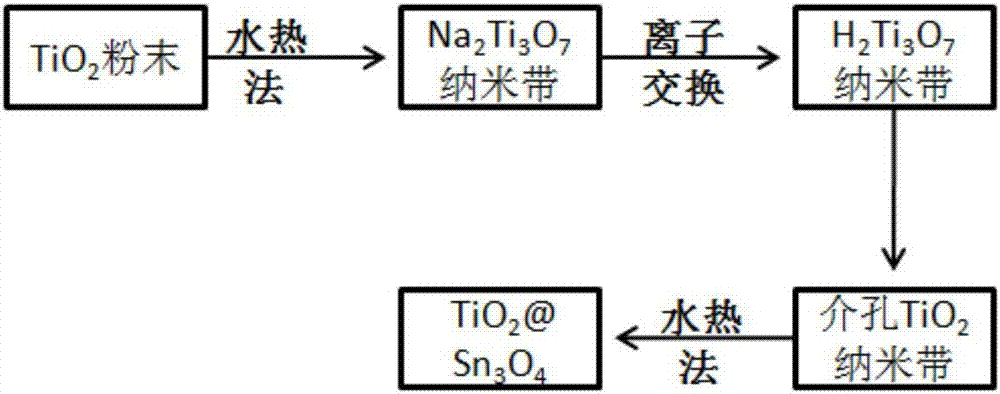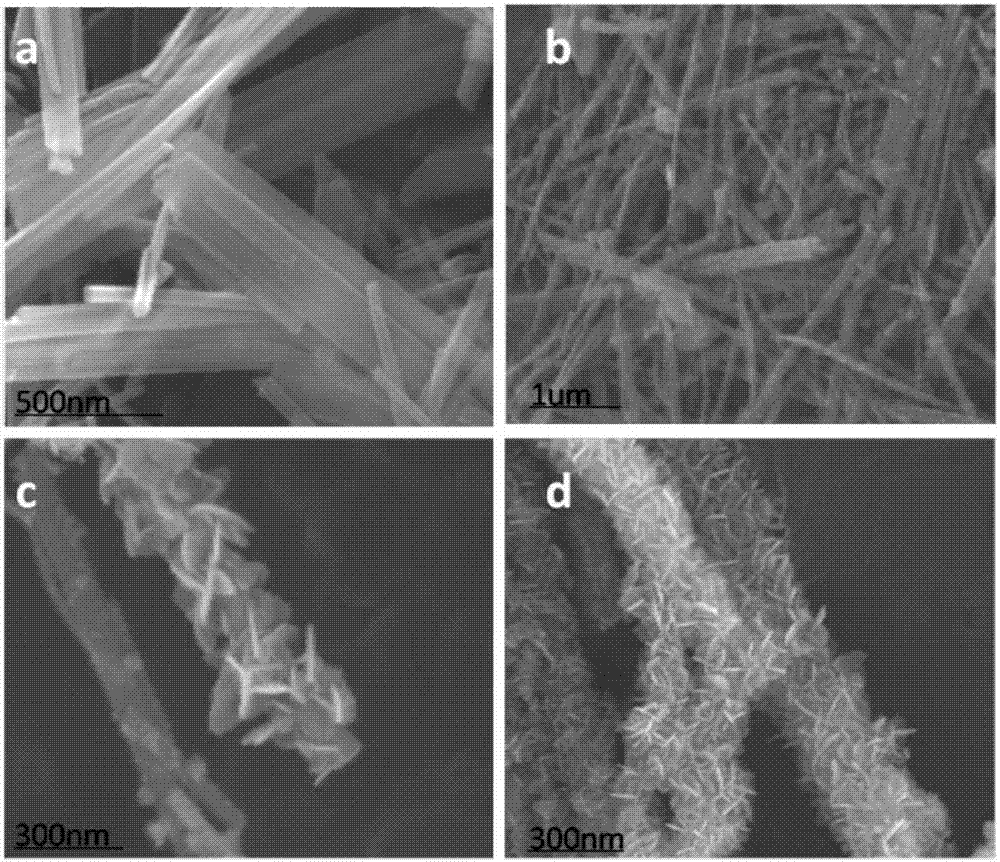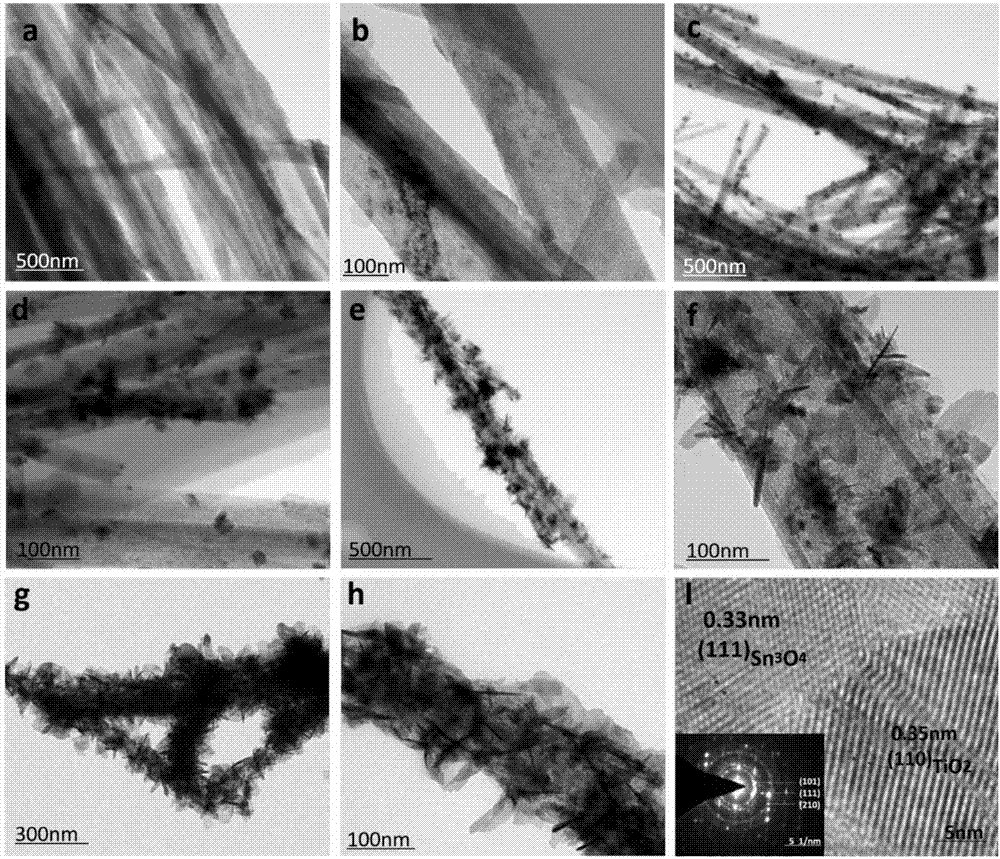Preparation method for TiO2/Sn3O4 negative electrode material for lithium ion battery
A technology of tritin tetroxide and lithium-ion batteries, applied in battery electrodes, nanotechnology for materials and surface science, secondary batteries, etc., can solve problems such as low capacity and poor cycle performance, and alleviate volume changes , good cycle performance, considerable capacity effect
- Summary
- Abstract
- Description
- Claims
- Application Information
AI Technical Summary
Problems solved by technology
Method used
Image
Examples
Embodiment 1
[0040] (1) A certain amount of commercial TiO 2 The powder is added to a molar concentration of 10±0.1molL -1 NaOH aqueous solution, stirred until completely dissolved; among them, TiO 2 The molar ratio of powder to NaOH is 1:80;
[0041] (2) Place the solution obtained in step (1) in a hydrothermal kettle with a certain volume and heat it up to 180°C at a heating rate of 8-10°C / min, and naturally cool to room temperature after reacting for 24 hours; wherein the solution and the hydrothermal kettle The volume ratio is 80:100;
[0042] (3) Wash the solid in the product obtained in step (2) several times with deionized water, place the washed product in a vacuum oven at 50-60°C and dry to constant weight, and grind to obtain Na 2 Ti 3 o 7 nanobelt;
[0043] (4) adding the product obtained in step (3) to a molar concentration of 1 ± 0.1molL -1 In aqueous HCl solution, stirred for 24h; where, Na 2 Ti 3 o 7 The volume ratio of nanobelts and HCl aqueous solution is 1:3.
...
Embodiment 2
[0055] (1) A certain amount of commercial TiO 2 The powder is added to a molar concentration of 10±0.1molL -1 NaOH aqueous solution, stirred until completely dissolved; among them, TiO 2 The molar ratio of powder to NaOH is 1:80;
[0056] (2) Place the solution obtained in step (1) in a hydrothermal kettle with a certain volume and heat it up to 180°C at a heating rate of 8-10°C / min, and naturally cool to room temperature after reacting for 24 hours; wherein the solution and the hydrothermal kettle The volume ratio is 80:100;
[0057] (3) Wash the solid in the product obtained in step (2) several times with deionized water, place the washed product in a vacuum oven at 50-60°C and dry to constant weight, and grind to obtain Na 2 Ti 3 o 7 nanobelt;
[0058] (4) adding the product obtained in step (3) to a molar concentration of 1 ± 0.1molL -1 In aqueous HCl solution, stirred for 24h; where, Na 2 Ti 3 o 7 The volume ratio of nanobelts and HCl aqueous solution is 1:3.
...
Embodiment 3
[0068] (1) A certain amount of commercial TiO 2 The powder is added to a molar concentration of 10±0.1molL -1 NaOH aqueous solution, stirred until completely dissolved; among them, TiO 2 The molar ratio of powder to NaOH is 1:80;
[0069] (2) Place the solution obtained in step (1) in a hydrothermal kettle with a certain volume and heat it up to 180°C at a heating rate of 8-10°C / min, and naturally cool to room temperature after reacting for 24 hours; wherein the solution and the hydrothermal kettle The volume ratio is 80:100;
[0070] (3) Wash the solid in the product obtained in step (2) several times with deionized water, place the washed product in a vacuum oven at 50-60°C and dry to constant weight, and grind to obtain Na 2 Ti 3 o 7 nanobelt;
[0071] (4) adding the product obtained in step (3) to a molar concentration of 1 ± 0.1molL -1 In aqueous HCl solution, stirred for 24h; where, Na 2 Ti 3 o 7 The volume ratio of nanobelts and HCl aqueous solution is 1:3.
...
PUM
 Login to View More
Login to View More Abstract
Description
Claims
Application Information
 Login to View More
Login to View More - R&D
- Intellectual Property
- Life Sciences
- Materials
- Tech Scout
- Unparalleled Data Quality
- Higher Quality Content
- 60% Fewer Hallucinations
Browse by: Latest US Patents, China's latest patents, Technical Efficacy Thesaurus, Application Domain, Technology Topic, Popular Technical Reports.
© 2025 PatSnap. All rights reserved.Legal|Privacy policy|Modern Slavery Act Transparency Statement|Sitemap|About US| Contact US: help@patsnap.com



